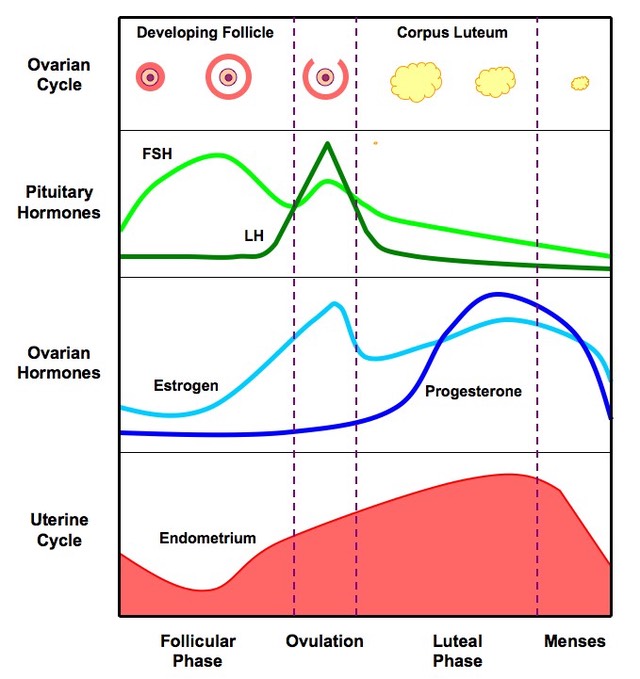6.6.1 Draw and label diagrams of the adult male and female reproductive systems
Male Reproductive System

Side View Front View
Female Reproductive System

Side View Front View
6.6.2 Outline the role of hormones in the menstrual cycle, including FSH (follicle stimulating hormone), LH (luteinising hormone), estrogen and progesterone

6.6.3 Annotate a graph showing hormone levels in the menstrual cycle, illustrating the relationship between changes in hormone levels and ovulation, menstruation and the thickening of the endometrium

Follicular Phase:
- FSH stimulates growth of several follicles
- Dominant follicle secretes estrogen
- Estrogen inhibits growth of other follicles (and FSH)
- Estrogen stimulates development of endometrium
Ovulation:
- A surge in LH causes ovulation (egg release)
- Rupturing of follicle creates a corpus luteum
Luteal Phase:
- Corpus luteum secretes progesterone (and estrogen)
- Progesterone stimulates development of endometrium
- Estrogen and progesterone inhibit FSH and LH
- Corpus luteum degrades over time
- When corpus luteum degrades, progesterone levels drop
- Without progesterone, endometrium cannot be maintained
- Endometrium is sloughed away (menstruation)
- No longer inhibited, FSH can start menstrual cycle again
- If fertilisation of egg occurs, the zygote releases a hormone (hCG) which maintains the corpus luteum
6.6.4 List three roles of testosterone in males
- Pre-natal development of male genitalia
- Development of secondary sex characteristics
- Maintenance of sex drive (libido)
6.6.5 Outline the process of in vitro fertilisation
In vitro fertilisation refers to fertilisation that occurs outside the body ('in vitro' = 'in glass')
- Stop normal menstrual cycle (with drugs)
- Hormone treatments to develop follicles (FSH to stimulate follicle growth ; hCG for follicle maturation)
- Extract multiple eggs from ovaries
- Sperm selected, prepared (capacitation) and then injected into egg via intra-cytoplasmic sperm injection (ICSI)
- Fertilisation occurs under controlled conditions (in vitro)
- Implantation of multiple embryos into uterus
- Test for pregnancy is conducted to see if implantation was successful
In Vitro Fertilisation

6.6.6 Discuss the ethical issues associated with IVF
Advantages of IVF
- Chance for infertile couples to have children
- Genetic screening of embryos could decrease suffering from genetic diseases
- Spare embryos can be stored for future pregnancies or used for stem cell research
Disadvantages of IVF
- IVF is expensive and might not be equally accessible to all
- Success rate is low (~15%) and therefore stressful for couples
- It could lead to eugenics (e.g. gender choice)
- Often leads to multiple pregnancies which may be unwanted, unable to be budgeted for and involves extra birth risks
- Issues concerning storage and disposal of unused embryos (right to life concerns)
- There are cultural and religious objections to embryo creation by such means
- Inherited forms of infertility may be passed on to children